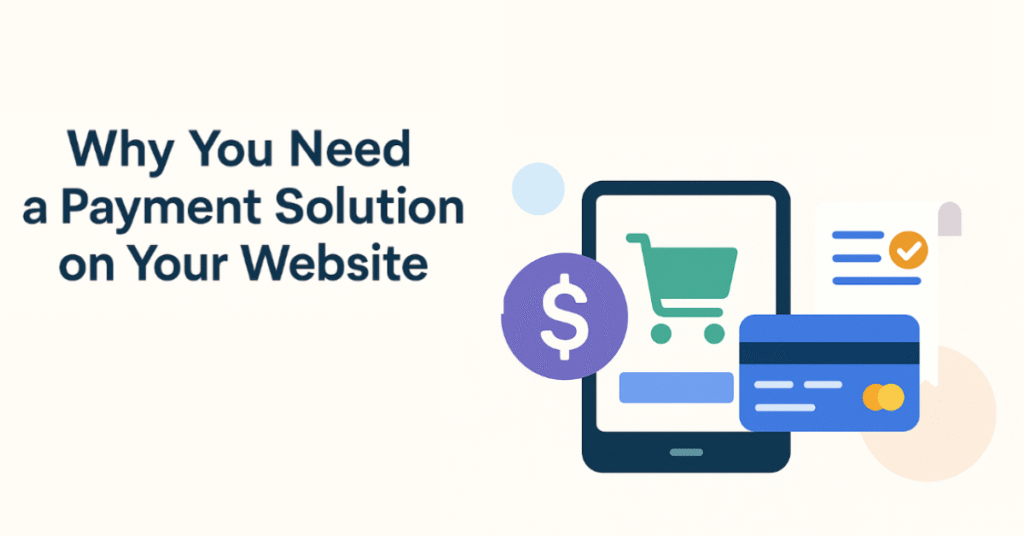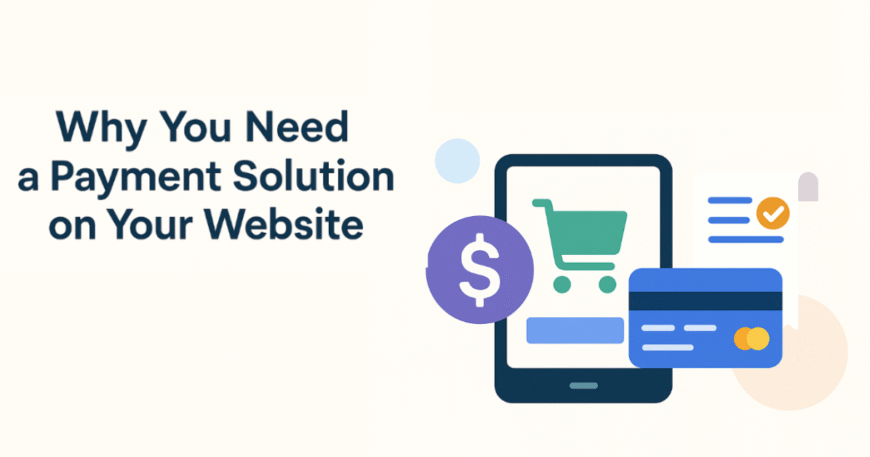
Table of Contents
- Introduction
- Convenience for Customers
- Faster Payments and Improved Cash Flow
- Enhanced Customer Trust and Security
- Access to a Global Market
- Better Analytics and Business Intelligence
- Reduced Cart Abandonment
- Recurring Billing and Subscription Management
- Multiple Payment Methods for Diverse Users
- Integration with Business Tools and Workflows
- Legal, Tax, and Compliance Benefits
- Competitive Advantage in the Digital Market
- Conclusion
Introduction
Why do you need a payment solution? In the rapidly evolving digital economy, businesses can no longer afford to treat their websites as mere digital brochures. Today, your website is your storefront, customer service desk, and most importantly—your point of sale. Whether you’re a small artisan selling handmade products, a SaaS startup offering subscription-based software, or a nonprofit collecting donations, a seamless and secure payment solution is essential.
Not only does it provide convenience for customers, but it also enables your business to operate efficiently, scale rapidly, and establish trust with online visitors. A website without a payment gateway is like a physical store without a cashier—visitors may browse, but they won’t buy.
1. Convenience for Customers
One of the most immediate benefits of integrating a payment solution on your website is the enhanced convenience it offers your customers. With an embedded payment system, users no longer need to leave your website to complete a transaction—everything happens in one place. This seamless checkout process minimizes confusion, reduces effort, and saves valuable time.
Today’s online consumers expect intuitive, frictionless shopping experiences. A smooth transaction flow not only satisfies existing users but also encourages first-time visitors to convert. When customers can complete a transaction in just a few clicks, the likelihood of abandonment reduces significantly, helping you secure more sales effortlessly.
2. Faster Payments and Improved Cash Flow
In traditional business settings, payments may be delayed due to manual invoicing, bank processing times, or customer procrastination. However, when you integrate an online payment system, those delays are minimized or eliminated altogether. Payments are processed instantly or within a predictable window, allowing you to maintain a steady and healthy cash flow.
This is especially beneficial for startups and small businesses where managing liquidity is critical to survival. With features like instant payouts, auto-generated receipts, and real-time transaction alerts, online payment gateways make financial tracking more efficient. You get paid faster, reduce overhead, and gain better control over your revenue cycle.
3. Enhanced Customer Trust and Security
In an era of rising cyber threats, customers are more cautious than ever when it comes to sharing financial information online. Using a reputable payment solution helps mitigate those concerns by offering secure, encrypted transactions and compliance with global standards like PCI-DSS. Most trusted payment gateways also include fraud detection tools and two-factor authentication to provide added layers of protection.
When customers see familiar and secure logos like PayPal, Razorpay, or Stripe on your checkout page, it instills immediate confidence. That trust directly impacts conversion rates and reduces chargebacks. Your reputation as a credible, secure online business is greatly enhanced through proper payment integration.
4. Access to a Global Market
The internet breaks down geographical barriers, and a solid payment solution takes full advantage of this by allowing your business to accept payments from anywhere in the world. With features like multi-currency support, language preferences, and international card processing, you open up your offerings to a global audience.
This is particularly useful if you’re selling digital products or services that don’t require shipping. Moreover, gateways that integrate with global wallets like Apple Pay, Google Pay, and Alipay make your platform more inclusive. In short, a globally accessible payment system extends your reach, increases your audience, and fuels your growth beyond borders
5. Better Analytics and Business Intelligence
Modern payment gateways don’t just process transactions—they offer detailed analytics and reporting tools that provide valuable insights into your business performance. From identifying peak purchasing hours to tracking average order value and customer lifetime value, the data collected can help you make smarter marketing and inventory decisions.
You can also track which payment methods are preferred, segment your customers, and understand seasonal purchase patterns. Integrating these insights into your CRM or business dashboard enables real-time decision-making. By leveraging the analytics provided by your payment platform, you turn every transaction into a learning opportunity, helping you grow and optimize faster than competitors.
6. Reduced Cart Abandonment
Cart abandonment is one of the most common challenges in e-commerce. Studies show that over 70% of online shopping carts are abandoned before checkout. One of the top reasons for this is a complicated or untrustworthy payment process.
By integrating a modern, user-friendly payment solution, you reduce friction and give users a sense of security during the final step of their journey. An optimized checkout page with a clean design and trusted logos can significantly increase conversions.
Key reasons why simplified payments reduce abandonment:
- Quick checkout increases purchase completion
- Fewer clicks mean less friction and less second-guessing
- Auto-fill features for returning customers improve speed
- Mobile-optimized payment pages are easier to use on smartphones
- Trusted payment provider logos improve credibility
- No mandatory sign-ups or account creation required
- Real-time payment confirmations reduce uncertainty
7. Recurring Billing and Subscription Management
If your business model includes memberships, subscriptions, or any type of recurring billing, a payment solution can automate these processes for you. Instead of manually invoicing customers every billing cycle, you can set up automatic recurring payments that ensure timely revenue collection.
This benefits both you and your customers—customers don’t have to remember due dates, and you maintain a consistent income stream. Payment platforms also allow customers to easily manage their subscriptions, including pausing, upgrading, or canceling with minimal hassle. This transparency and control enhance customer satisfaction while also reducing churn and improving long-term revenue stability.

8. Multiple Payment Methods by Payment Solution for Diverse Users
Not all customers use the same payment method. Some prefer credit cards, others use UPI, net banking, e-wallets, or even Buy Now Pay Later (BNPL) services. A good payment gateway accommodates these preferences, ensuring you don’t lose a sale just because a customer couldn’t pay the way they wanted to. The broader your range of accepted payment types, the more inclusive and customer-friendly your platform becomes.
Benefits of offering multiple payment modes:
- Increased satisfaction through personalized checkout experiences
- Access to new customer segments, including those with limited banking
- Higher conversion rates by minimizing payment failures
- Improved credibility with a diverse customer base
- Streamlined mobile checkouts with digital wallets
- Enhanced convenience leading to quicker buying decisions
- Greater trust due to familiar payment options
9. Integration with Business Tools and Workflows
The real power of a payment solution is unlocked when it’s integrated with your existing systems—like CRMs, ERPs, inventory software, or marketing automation tools. For instance, when a customer makes a purchase, it can automatically update your inventory, trigger a welcome email, and log the transaction into your CRM.
This reduces manual work, minimizes errors, and speeds up operational processes. Businesses can also automate billing, apply discount codes, and personalize post-purchase interactions using synced data from the payment platform. In short, payment solutions help build a fully connected, data-driven digital business ecosystem.
10. Legal, Tax, and Compliance Benefits
Handling taxes, invoices, and financial compliance manually can be a nightmare, especially as your business grows. Payment platforms simplify this by automating invoice generation, tax calculations, and record-keeping. Some gateways even integrate with your accounting software to help you prepare GST returns or export data for audits.
This reduces the chances of human error and keeps your business compliant with government regulations. For international sellers, features like VAT support and region-specific tax tools ensure smooth cross-border transactions. A payment system isn’t just about collecting money—it’s about doing so responsibly and legally.
11. Competitive Advantage in the Digital Market
In today’s saturated market, having a robust and intuitive payment system can serve as a competitive differentiator. A poorly designed checkout process could drive potential customers to your competitors, even if your product is better or cheaper.
On the other hand, a site with seamless payment integration gives off a professional vibe and assures customers they’re dealing with a reputable business. It becomes a part of your brand experience and impacts how people perceive your reliability. As digital expectations continue to rise, businesses that offer smart, secure, and flexible payment options are more likely to earn customer loyalty and market share.
Conclusion
A website without a payment solution is like building a shopping mall with no exit—it may attract visitors, but it won’t generate business. Payment gateways have evolved from being simple processors of credit cards to powerful platforms that enhance customer experience, operational efficiency, and financial management.
From reducing friction during checkout to expanding your global reach, the advantages are clear and far-reaching. Investing in the right payment solution not only boosts your revenue potential but also builds trust, streamlines processes, and sets the foundation for future growth. If you’re serious about digital success, this is the first tool you must get right.
Frequently Asked Questions (FAQs)
1. What is a website payment solution?
A website payment solution is a software or service integrated into a website that enables businesses to accept and process payments securely online. These solutions can support credit/debit cards, digital wallets, UPI, net banking, and other online payment methods.
2. Why can’t I just use manual bank transfers for online orders?
Manual bank transfers are time-consuming, error-prone, and lack automation. A payment solution streamlines the process, provides real-time confirmations, improves customer experience, and offers advanced features like recurring billing, invoicing, and fraud detection.
3. Is it safe to accept payments directly on my website?
Yes, provided you use a secure and reputable payment gateway. Trusted providers offer encryption, fraud protection, PCI-DSS compliance, and two-factor authentication to ensure customer data and financial transactions are fully protected.
4. Can I still integrate a payment solution if I don’t sell products online?
Absolutely. Payment solutions are also useful for service providers, freelancers, consultants, NGOs, and educators who need to collect fees, donations, or payments for bookings and subscriptions directly from their websites.




